Flight 5481: Safety, Health, and Environmental Engineering Report
VerifiedAdded on 2022/08/19
|10
|4219
|9
Report
AI Summary
This report provides a comprehensive analysis of the Flight 5481 crash, which occurred shortly after takeoff due to a loss of pitch control. The investigation reveals critical failures in maintenance procedures, documentation, and oversight, particularly concerning the elevator control system. The report examines the health and safety aspects, highlighting the importance of maintaining a safe aviation environment to mitigate potential risks to passengers and crew. It delves into the causes of the accident, including mechanical faults, incorrect installations, and inadequate training. The report also includes a risk assessment, emphasizing the importance of hazard identification, evaluation, and control measures to prevent future incidents. The report suggests improvements in training, weight and balance calculations, and quality assurance to enhance safety protocols and prevent similar tragedies.
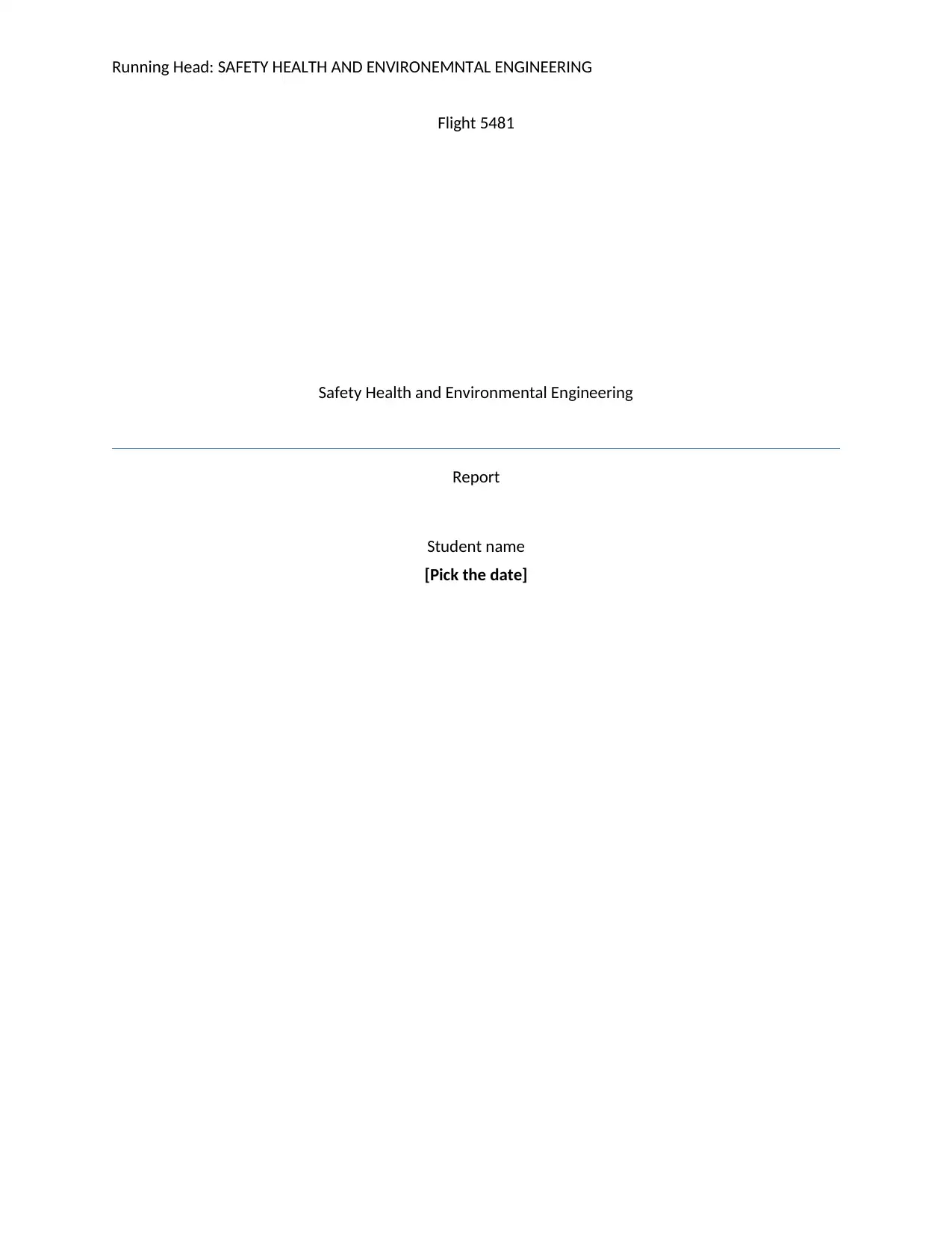
Running Head: SAFETY HEALTH AND ENVIRONEMNTAL ENGINEERING
Flight 5481
Safety Health and Environmental Engineering
Report
Student name
[Pick the date]
Flight 5481
Safety Health and Environmental Engineering
Report
Student name
[Pick the date]
Paraphrase This Document
Need a fresh take? Get an instant paraphrase of this document with our AI Paraphraser
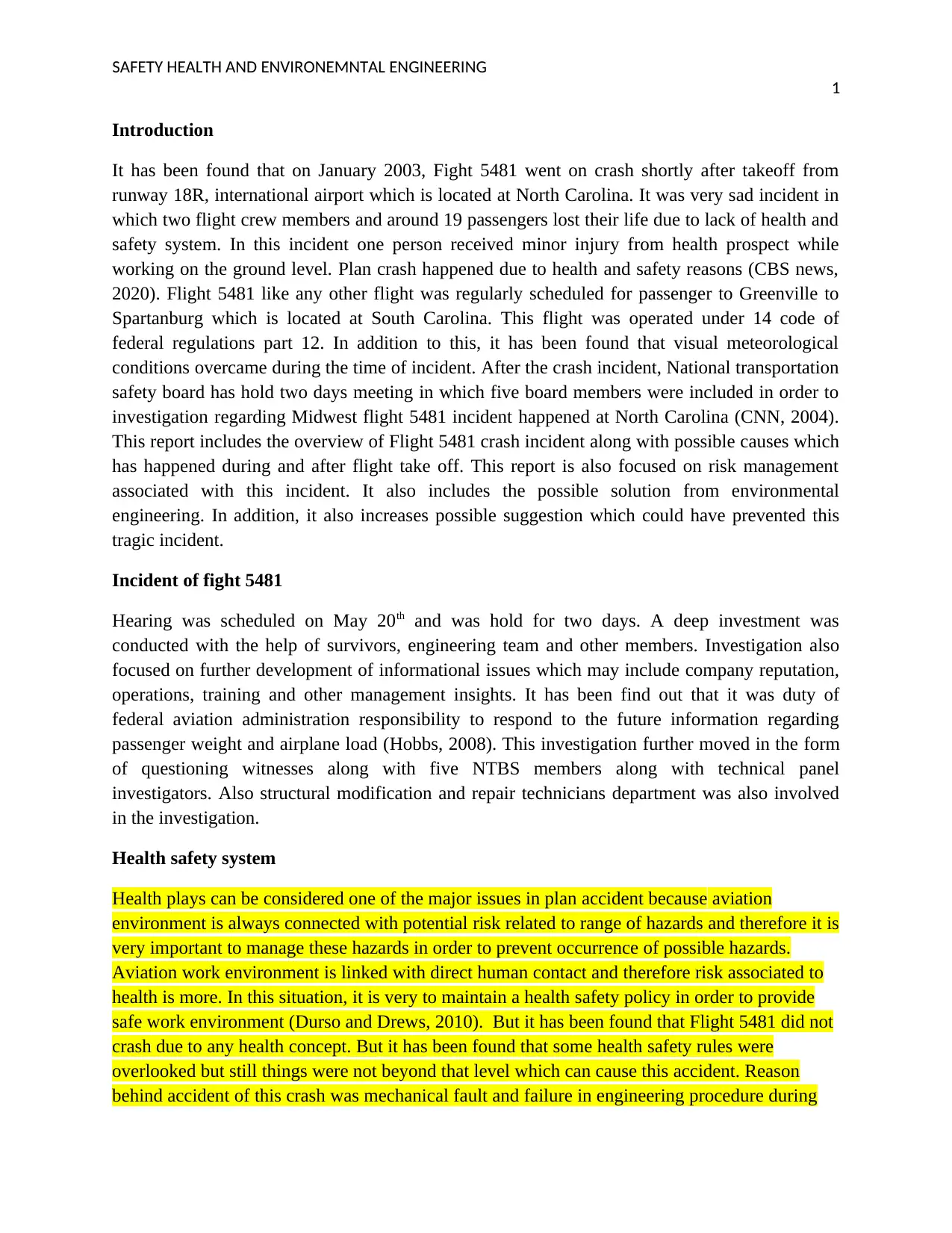
SAFETY HEALTH AND ENVIRONEMNTAL ENGINEERING
1
Introduction
It has been found that on January 2003, Fight 5481 went on crash shortly after takeoff from
runway 18R, international airport which is located at North Carolina. It was very sad incident in
which two flight crew members and around 19 passengers lost their life due to lack of health and
safety system. In this incident one person received minor injury from health prospect while
working on the ground level. Plan crash happened due to health and safety reasons (CBS news,
2020). Flight 5481 like any other flight was regularly scheduled for passenger to Greenville to
Spartanburg which is located at South Carolina. This flight was operated under 14 code of
federal regulations part 12. In addition to this, it has been found that visual meteorological
conditions overcame during the time of incident. After the crash incident, National transportation
safety board has hold two days meeting in which five board members were included in order to
investigation regarding Midwest flight 5481 incident happened at North Carolina (CNN, 2004).
This report includes the overview of Flight 5481 crash incident along with possible causes which
has happened during and after flight take off. This report is also focused on risk management
associated with this incident. It also includes the possible solution from environmental
engineering. In addition, it also increases possible suggestion which could have prevented this
tragic incident.
Incident of fight 5481
Hearing was scheduled on May 20th and was hold for two days. A deep investment was
conducted with the help of survivors, engineering team and other members. Investigation also
focused on further development of informational issues which may include company reputation,
operations, training and other management insights. It has been find out that it was duty of
federal aviation administration responsibility to respond to the future information regarding
passenger weight and airplane load (Hobbs, 2008). This investigation further moved in the form
of questioning witnesses along with five NTBS members along with technical panel
investigators. Also structural modification and repair technicians department was also involved
in the investigation.
Health safety system
Health plays can be considered one of the major issues in plan accident because aviation
environment is always connected with potential risk related to range of hazards and therefore it is
very important to manage these hazards in order to prevent occurrence of possible hazards.
Aviation work environment is linked with direct human contact and therefore risk associated to
health is more. In this situation, it is very to maintain a health safety policy in order to provide
safe work environment (Durso and Drews, 2010). But it has been found that Flight 5481 did not
crash due to any health concept. But it has been found that some health safety rules were
overlooked but still things were not beyond that level which can cause this accident. Reason
behind accident of this crash was mechanical fault and failure in engineering procedure during
1
Introduction
It has been found that on January 2003, Fight 5481 went on crash shortly after takeoff from
runway 18R, international airport which is located at North Carolina. It was very sad incident in
which two flight crew members and around 19 passengers lost their life due to lack of health and
safety system. In this incident one person received minor injury from health prospect while
working on the ground level. Plan crash happened due to health and safety reasons (CBS news,
2020). Flight 5481 like any other flight was regularly scheduled for passenger to Greenville to
Spartanburg which is located at South Carolina. This flight was operated under 14 code of
federal regulations part 12. In addition to this, it has been found that visual meteorological
conditions overcame during the time of incident. After the crash incident, National transportation
safety board has hold two days meeting in which five board members were included in order to
investigation regarding Midwest flight 5481 incident happened at North Carolina (CNN, 2004).
This report includes the overview of Flight 5481 crash incident along with possible causes which
has happened during and after flight take off. This report is also focused on risk management
associated with this incident. It also includes the possible solution from environmental
engineering. In addition, it also increases possible suggestion which could have prevented this
tragic incident.
Incident of fight 5481
Hearing was scheduled on May 20th and was hold for two days. A deep investment was
conducted with the help of survivors, engineering team and other members. Investigation also
focused on further development of informational issues which may include company reputation,
operations, training and other management insights. It has been find out that it was duty of
federal aviation administration responsibility to respond to the future information regarding
passenger weight and airplane load (Hobbs, 2008). This investigation further moved in the form
of questioning witnesses along with five NTBS members along with technical panel
investigators. Also structural modification and repair technicians department was also involved
in the investigation.
Health safety system
Health plays can be considered one of the major issues in plan accident because aviation
environment is always connected with potential risk related to range of hazards and therefore it is
very important to manage these hazards in order to prevent occurrence of possible hazards.
Aviation work environment is linked with direct human contact and therefore risk associated to
health is more. In this situation, it is very to maintain a health safety policy in order to provide
safe work environment (Durso and Drews, 2010). But it has been found that Flight 5481 did not
crash due to any health concept. But it has been found that some health safety rules were
overlooked but still things were not beyond that level which can cause this accident. Reason
behind accident of this crash was mechanical fault and failure in engineering procedure during
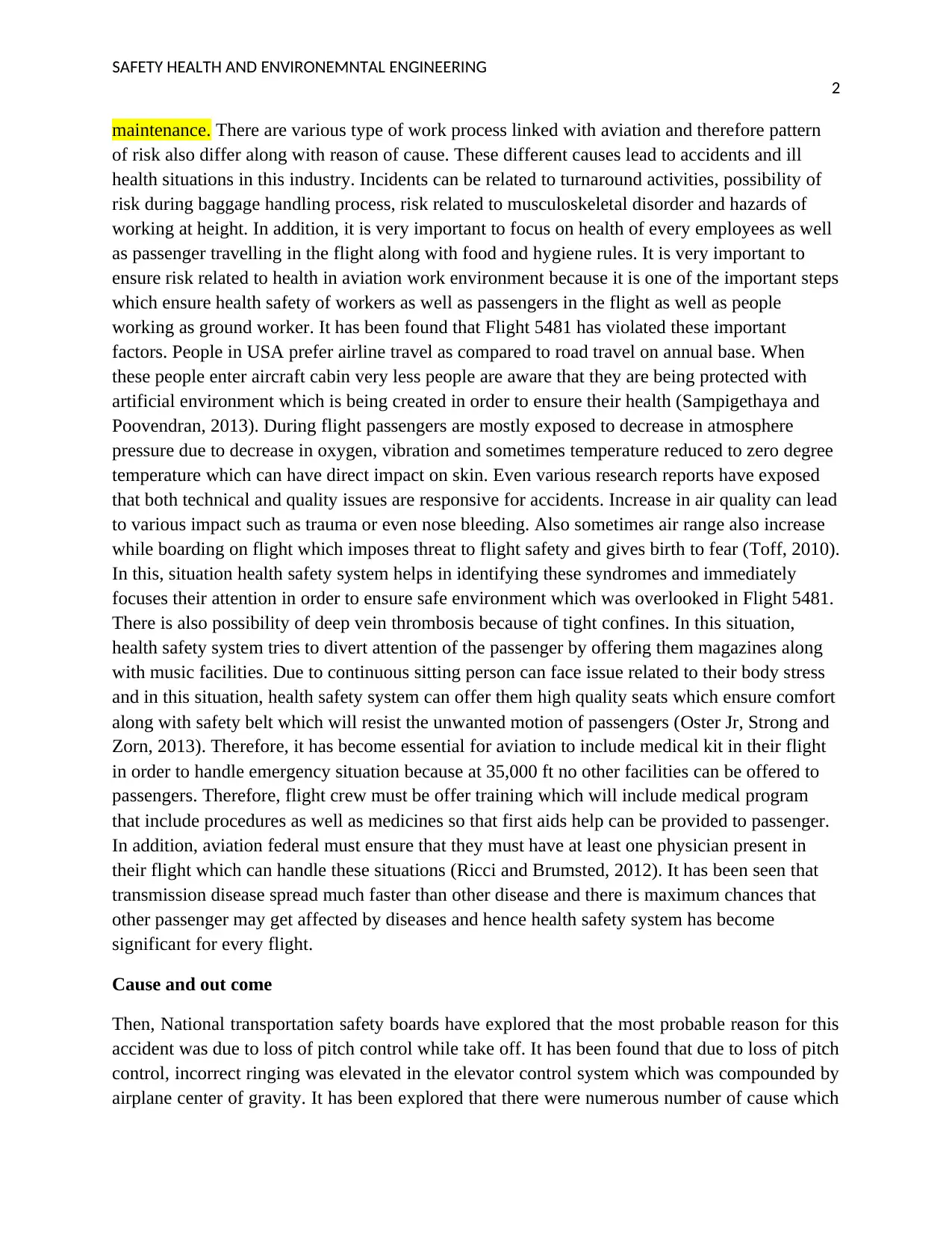
SAFETY HEALTH AND ENVIRONEMNTAL ENGINEERING
2
maintenance. There are various type of work process linked with aviation and therefore pattern
of risk also differ along with reason of cause. These different causes lead to accidents and ill
health situations in this industry. Incidents can be related to turnaround activities, possibility of
risk during baggage handling process, risk related to musculoskeletal disorder and hazards of
working at height. In addition, it is very important to focus on health of every employees as well
as passenger travelling in the flight along with food and hygiene rules. It is very important to
ensure risk related to health in aviation work environment because it is one of the important steps
which ensure health safety of workers as well as passengers in the flight as well as people
working as ground worker. It has been found that Flight 5481 has violated these important
factors. People in USA prefer airline travel as compared to road travel on annual base. When
these people enter aircraft cabin very less people are aware that they are being protected with
artificial environment which is being created in order to ensure their health (Sampigethaya and
Poovendran, 2013). During flight passengers are mostly exposed to decrease in atmosphere
pressure due to decrease in oxygen, vibration and sometimes temperature reduced to zero degree
temperature which can have direct impact on skin. Even various research reports have exposed
that both technical and quality issues are responsive for accidents. Increase in air quality can lead
to various impact such as trauma or even nose bleeding. Also sometimes air range also increase
while boarding on flight which imposes threat to flight safety and gives birth to fear (Toff, 2010).
In this, situation health safety system helps in identifying these syndromes and immediately
focuses their attention in order to ensure safe environment which was overlooked in Flight 5481.
There is also possibility of deep vein thrombosis because of tight confines. In this situation,
health safety system tries to divert attention of the passenger by offering them magazines along
with music facilities. Due to continuous sitting person can face issue related to their body stress
and in this situation, health safety system can offer them high quality seats which ensure comfort
along with safety belt which will resist the unwanted motion of passengers (Oster Jr, Strong and
Zorn, 2013). Therefore, it has become essential for aviation to include medical kit in their flight
in order to handle emergency situation because at 35,000 ft no other facilities can be offered to
passengers. Therefore, flight crew must be offer training which will include medical program
that include procedures as well as medicines so that first aids help can be provided to passenger.
In addition, aviation federal must ensure that they must have at least one physician present in
their flight which can handle these situations (Ricci and Brumsted, 2012). It has been seen that
transmission disease spread much faster than other disease and there is maximum chances that
other passenger may get affected by diseases and hence health safety system has become
significant for every flight.
Cause and out come
Then, National transportation safety boards have explored that the most probable reason for this
accident was due to loss of pitch control while take off. It has been found that due to loss of pitch
control, incorrect ringing was elevated in the elevator control system which was compounded by
airplane center of gravity. It has been explored that there were numerous number of cause which
2
maintenance. There are various type of work process linked with aviation and therefore pattern
of risk also differ along with reason of cause. These different causes lead to accidents and ill
health situations in this industry. Incidents can be related to turnaround activities, possibility of
risk during baggage handling process, risk related to musculoskeletal disorder and hazards of
working at height. In addition, it is very important to focus on health of every employees as well
as passenger travelling in the flight along with food and hygiene rules. It is very important to
ensure risk related to health in aviation work environment because it is one of the important steps
which ensure health safety of workers as well as passengers in the flight as well as people
working as ground worker. It has been found that Flight 5481 has violated these important
factors. People in USA prefer airline travel as compared to road travel on annual base. When
these people enter aircraft cabin very less people are aware that they are being protected with
artificial environment which is being created in order to ensure their health (Sampigethaya and
Poovendran, 2013). During flight passengers are mostly exposed to decrease in atmosphere
pressure due to decrease in oxygen, vibration and sometimes temperature reduced to zero degree
temperature which can have direct impact on skin. Even various research reports have exposed
that both technical and quality issues are responsive for accidents. Increase in air quality can lead
to various impact such as trauma or even nose bleeding. Also sometimes air range also increase
while boarding on flight which imposes threat to flight safety and gives birth to fear (Toff, 2010).
In this, situation health safety system helps in identifying these syndromes and immediately
focuses their attention in order to ensure safe environment which was overlooked in Flight 5481.
There is also possibility of deep vein thrombosis because of tight confines. In this situation,
health safety system tries to divert attention of the passenger by offering them magazines along
with music facilities. Due to continuous sitting person can face issue related to their body stress
and in this situation, health safety system can offer them high quality seats which ensure comfort
along with safety belt which will resist the unwanted motion of passengers (Oster Jr, Strong and
Zorn, 2013). Therefore, it has become essential for aviation to include medical kit in their flight
in order to handle emergency situation because at 35,000 ft no other facilities can be offered to
passengers. Therefore, flight crew must be offer training which will include medical program
that include procedures as well as medicines so that first aids help can be provided to passenger.
In addition, aviation federal must ensure that they must have at least one physician present in
their flight which can handle these situations (Ricci and Brumsted, 2012). It has been seen that
transmission disease spread much faster than other disease and there is maximum chances that
other passenger may get affected by diseases and hence health safety system has become
significant for every flight.
Cause and out come
Then, National transportation safety boards have explored that the most probable reason for this
accident was due to loss of pitch control while take off. It has been found that due to loss of pitch
control, incorrect ringing was elevated in the elevator control system which was compounded by
airplane center of gravity. It has been explored that there were numerous number of cause which
⊘ This is a preview!⊘
Do you want full access?
Subscribe today to unlock all pages.

Trusted by 1+ million students worldwide
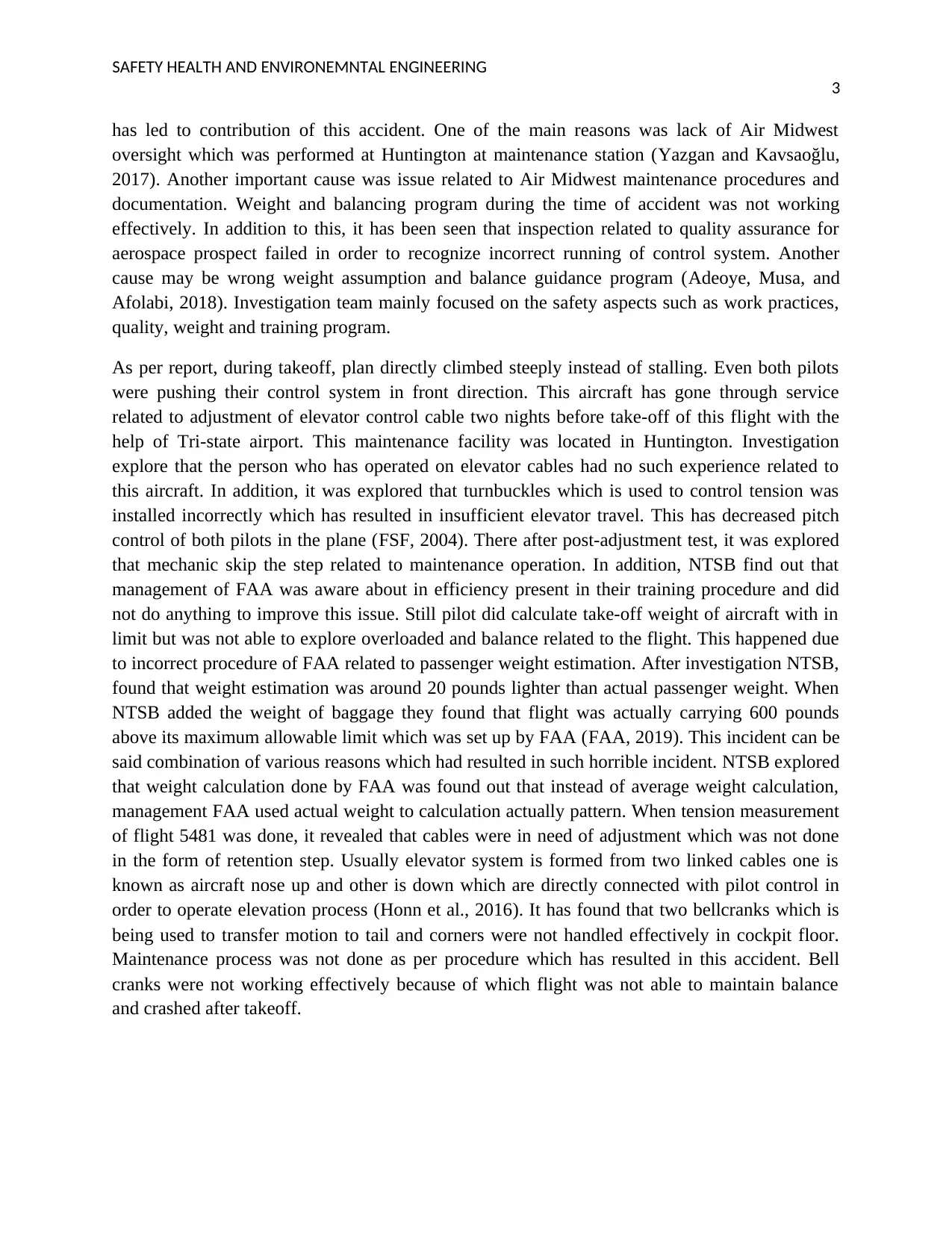
SAFETY HEALTH AND ENVIRONEMNTAL ENGINEERING
3
has led to contribution of this accident. One of the main reasons was lack of Air Midwest
oversight which was performed at Huntington at maintenance station (Yazgan and Kavsaoğlu,
2017). Another important cause was issue related to Air Midwest maintenance procedures and
documentation. Weight and balancing program during the time of accident was not working
effectively. In addition to this, it has been seen that inspection related to quality assurance for
aerospace prospect failed in order to recognize incorrect running of control system. Another
cause may be wrong weight assumption and balance guidance program (Adeoye, Musa, and
Afolabi, 2018). Investigation team mainly focused on the safety aspects such as work practices,
quality, weight and training program.
As per report, during takeoff, plan directly climbed steeply instead of stalling. Even both pilots
were pushing their control system in front direction. This aircraft has gone through service
related to adjustment of elevator control cable two nights before take-off of this flight with the
help of Tri-state airport. This maintenance facility was located in Huntington. Investigation
explore that the person who has operated on elevator cables had no such experience related to
this aircraft. In addition, it was explored that turnbuckles which is used to control tension was
installed incorrectly which has resulted in insufficient elevator travel. This has decreased pitch
control of both pilots in the plane (FSF, 2004). There after post-adjustment test, it was explored
that mechanic skip the step related to maintenance operation. In addition, NTSB find out that
management of FAA was aware about in efficiency present in their training procedure and did
not do anything to improve this issue. Still pilot did calculate take-off weight of aircraft with in
limit but was not able to explore overloaded and balance related to the flight. This happened due
to incorrect procedure of FAA related to passenger weight estimation. After investigation NTSB,
found that weight estimation was around 20 pounds lighter than actual passenger weight. When
NTSB added the weight of baggage they found that flight was actually carrying 600 pounds
above its maximum allowable limit which was set up by FAA (FAA, 2019). This incident can be
said combination of various reasons which had resulted in such horrible incident. NTSB explored
that weight calculation done by FAA was found out that instead of average weight calculation,
management FAA used actual weight to calculation actually pattern. When tension measurement
of flight 5481 was done, it revealed that cables were in need of adjustment which was not done
in the form of retention step. Usually elevator system is formed from two linked cables one is
known as aircraft nose up and other is down which are directly connected with pilot control in
order to operate elevation process (Honn et al., 2016). It has found that two bellcranks which is
being used to transfer motion to tail and corners were not handled effectively in cockpit floor.
Maintenance process was not done as per procedure which has resulted in this accident. Bell
cranks were not working effectively because of which flight was not able to maintain balance
and crashed after takeoff.
3
has led to contribution of this accident. One of the main reasons was lack of Air Midwest
oversight which was performed at Huntington at maintenance station (Yazgan and Kavsaoğlu,
2017). Another important cause was issue related to Air Midwest maintenance procedures and
documentation. Weight and balancing program during the time of accident was not working
effectively. In addition to this, it has been seen that inspection related to quality assurance for
aerospace prospect failed in order to recognize incorrect running of control system. Another
cause may be wrong weight assumption and balance guidance program (Adeoye, Musa, and
Afolabi, 2018). Investigation team mainly focused on the safety aspects such as work practices,
quality, weight and training program.
As per report, during takeoff, plan directly climbed steeply instead of stalling. Even both pilots
were pushing their control system in front direction. This aircraft has gone through service
related to adjustment of elevator control cable two nights before take-off of this flight with the
help of Tri-state airport. This maintenance facility was located in Huntington. Investigation
explore that the person who has operated on elevator cables had no such experience related to
this aircraft. In addition, it was explored that turnbuckles which is used to control tension was
installed incorrectly which has resulted in insufficient elevator travel. This has decreased pitch
control of both pilots in the plane (FSF, 2004). There after post-adjustment test, it was explored
that mechanic skip the step related to maintenance operation. In addition, NTSB find out that
management of FAA was aware about in efficiency present in their training procedure and did
not do anything to improve this issue. Still pilot did calculate take-off weight of aircraft with in
limit but was not able to explore overloaded and balance related to the flight. This happened due
to incorrect procedure of FAA related to passenger weight estimation. After investigation NTSB,
found that weight estimation was around 20 pounds lighter than actual passenger weight. When
NTSB added the weight of baggage they found that flight was actually carrying 600 pounds
above its maximum allowable limit which was set up by FAA (FAA, 2019). This incident can be
said combination of various reasons which had resulted in such horrible incident. NTSB explored
that weight calculation done by FAA was found out that instead of average weight calculation,
management FAA used actual weight to calculation actually pattern. When tension measurement
of flight 5481 was done, it revealed that cables were in need of adjustment which was not done
in the form of retention step. Usually elevator system is formed from two linked cables one is
known as aircraft nose up and other is down which are directly connected with pilot control in
order to operate elevation process (Honn et al., 2016). It has found that two bellcranks which is
being used to transfer motion to tail and corners were not handled effectively in cockpit floor.
Maintenance process was not done as per procedure which has resulted in this accident. Bell
cranks were not working effectively because of which flight was not able to maintain balance
and crashed after takeoff.
Paraphrase This Document
Need a fresh take? Get an instant paraphrase of this document with our AI Paraphraser
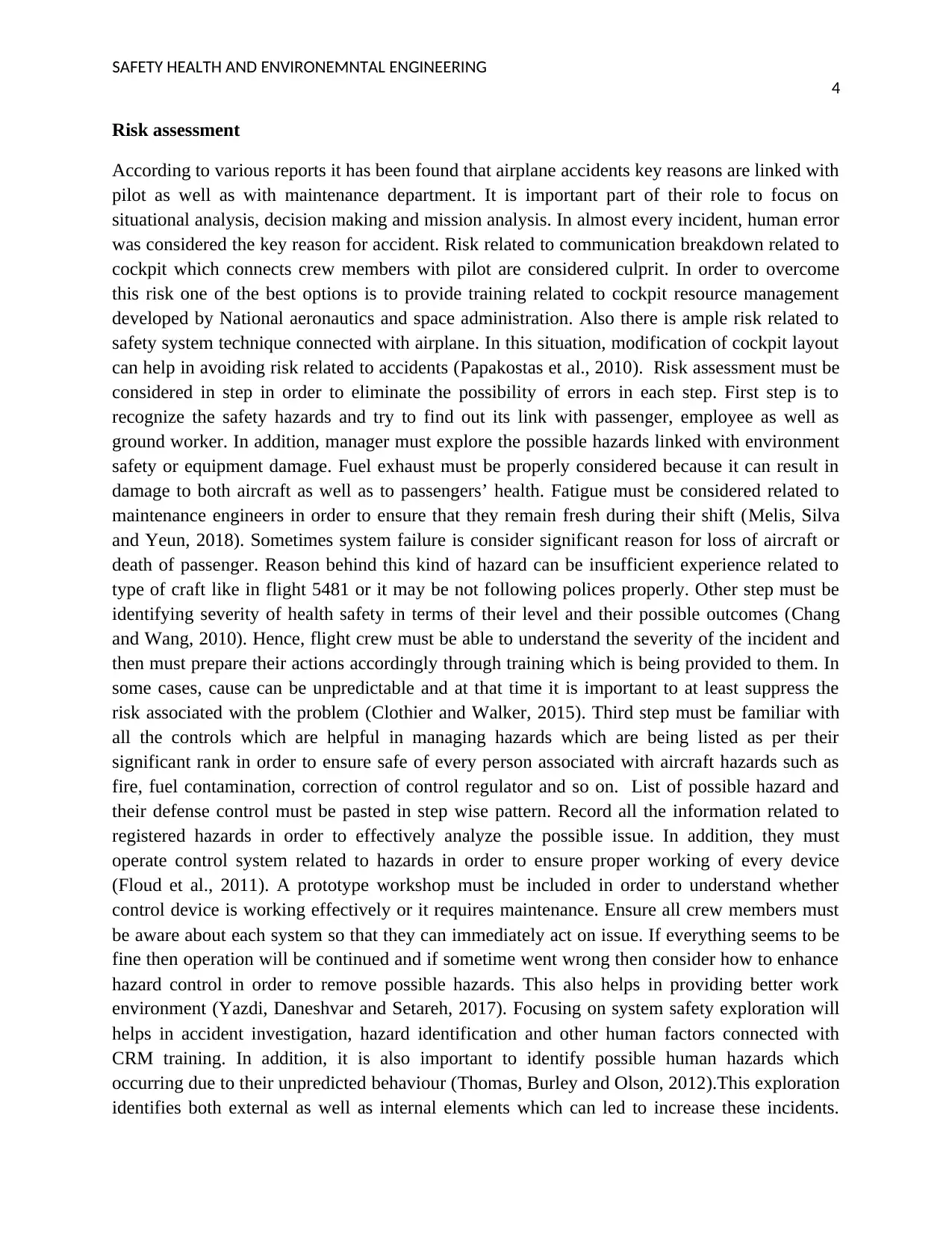
SAFETY HEALTH AND ENVIRONEMNTAL ENGINEERING
4
Risk assessment
According to various reports it has been found that airplane accidents key reasons are linked with
pilot as well as with maintenance department. It is important part of their role to focus on
situational analysis, decision making and mission analysis. In almost every incident, human error
was considered the key reason for accident. Risk related to communication breakdown related to
cockpit which connects crew members with pilot are considered culprit. In order to overcome
this risk one of the best options is to provide training related to cockpit resource management
developed by National aeronautics and space administration. Also there is ample risk related to
safety system technique connected with airplane. In this situation, modification of cockpit layout
can help in avoiding risk related to accidents (Papakostas et al., 2010). Risk assessment must be
considered in step in order to eliminate the possibility of errors in each step. First step is to
recognize the safety hazards and try to find out its link with passenger, employee as well as
ground worker. In addition, manager must explore the possible hazards linked with environment
safety or equipment damage. Fuel exhaust must be properly considered because it can result in
damage to both aircraft as well as to passengers’ health. Fatigue must be considered related to
maintenance engineers in order to ensure that they remain fresh during their shift (Melis, Silva
and Yeun, 2018). Sometimes system failure is consider significant reason for loss of aircraft or
death of passenger. Reason behind this kind of hazard can be insufficient experience related to
type of craft like in flight 5481 or it may be not following polices properly. Other step must be
identifying severity of health safety in terms of their level and their possible outcomes (Chang
and Wang, 2010). Hence, flight crew must be able to understand the severity of the incident and
then must prepare their actions accordingly through training which is being provided to them. In
some cases, cause can be unpredictable and at that time it is important to at least suppress the
risk associated with the problem (Clothier and Walker, 2015). Third step must be familiar with
all the controls which are helpful in managing hazards which are being listed as per their
significant rank in order to ensure safe of every person associated with aircraft hazards such as
fire, fuel contamination, correction of control regulator and so on. List of possible hazard and
their defense control must be pasted in step wise pattern. Record all the information related to
registered hazards in order to effectively analyze the possible issue. In addition, they must
operate control system related to hazards in order to ensure proper working of every device
(Floud et al., 2011). A prototype workshop must be included in order to understand whether
control device is working effectively or it requires maintenance. Ensure all crew members must
be aware about each system so that they can immediately act on issue. If everything seems to be
fine then operation will be continued and if sometime went wrong then consider how to enhance
hazard control in order to remove possible hazards. This also helps in providing better work
environment (Yazdi, Daneshvar and Setareh, 2017). Focusing on system safety exploration will
helps in accident investigation, hazard identification and other human factors connected with
CRM training. In addition, it is also important to identify possible human hazards which
occurring due to their unpredicted behaviour (Thomas, Burley and Olson, 2012).This exploration
identifies both external as well as internal elements which can led to increase these incidents.
4
Risk assessment
According to various reports it has been found that airplane accidents key reasons are linked with
pilot as well as with maintenance department. It is important part of their role to focus on
situational analysis, decision making and mission analysis. In almost every incident, human error
was considered the key reason for accident. Risk related to communication breakdown related to
cockpit which connects crew members with pilot are considered culprit. In order to overcome
this risk one of the best options is to provide training related to cockpit resource management
developed by National aeronautics and space administration. Also there is ample risk related to
safety system technique connected with airplane. In this situation, modification of cockpit layout
can help in avoiding risk related to accidents (Papakostas et al., 2010). Risk assessment must be
considered in step in order to eliminate the possibility of errors in each step. First step is to
recognize the safety hazards and try to find out its link with passenger, employee as well as
ground worker. In addition, manager must explore the possible hazards linked with environment
safety or equipment damage. Fuel exhaust must be properly considered because it can result in
damage to both aircraft as well as to passengers’ health. Fatigue must be considered related to
maintenance engineers in order to ensure that they remain fresh during their shift (Melis, Silva
and Yeun, 2018). Sometimes system failure is consider significant reason for loss of aircraft or
death of passenger. Reason behind this kind of hazard can be insufficient experience related to
type of craft like in flight 5481 or it may be not following polices properly. Other step must be
identifying severity of health safety in terms of their level and their possible outcomes (Chang
and Wang, 2010). Hence, flight crew must be able to understand the severity of the incident and
then must prepare their actions accordingly through training which is being provided to them. In
some cases, cause can be unpredictable and at that time it is important to at least suppress the
risk associated with the problem (Clothier and Walker, 2015). Third step must be familiar with
all the controls which are helpful in managing hazards which are being listed as per their
significant rank in order to ensure safe of every person associated with aircraft hazards such as
fire, fuel contamination, correction of control regulator and so on. List of possible hazard and
their defense control must be pasted in step wise pattern. Record all the information related to
registered hazards in order to effectively analyze the possible issue. In addition, they must
operate control system related to hazards in order to ensure proper working of every device
(Floud et al., 2011). A prototype workshop must be included in order to understand whether
control device is working effectively or it requires maintenance. Ensure all crew members must
be aware about each system so that they can immediately act on issue. If everything seems to be
fine then operation will be continued and if sometime went wrong then consider how to enhance
hazard control in order to remove possible hazards. This also helps in providing better work
environment (Yazdi, Daneshvar and Setareh, 2017). Focusing on system safety exploration will
helps in accident investigation, hazard identification and other human factors connected with
CRM training. In addition, it is also important to identify possible human hazards which
occurring due to their unpredicted behaviour (Thomas, Burley and Olson, 2012).This exploration
identifies both external as well as internal elements which can led to increase these incidents.
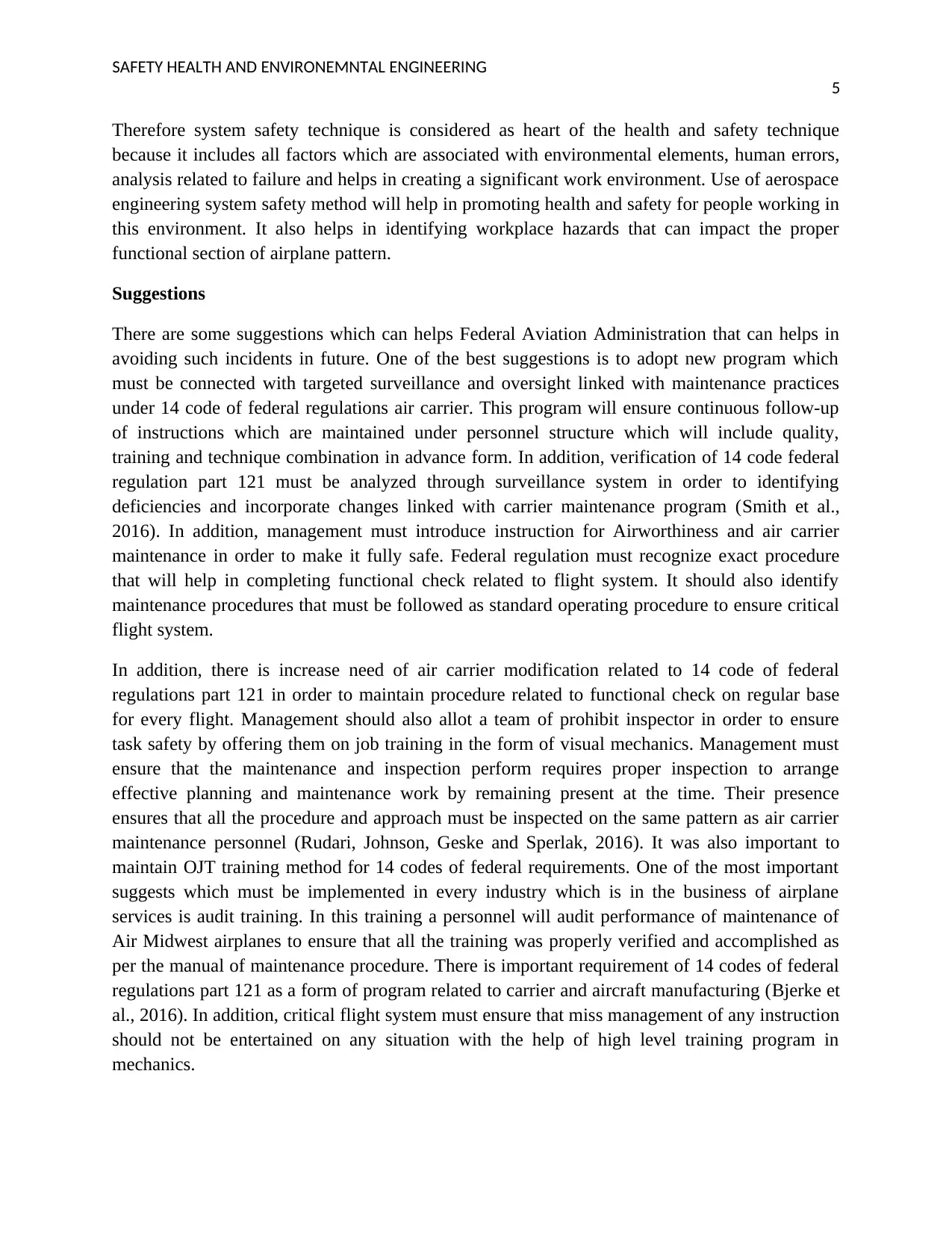
SAFETY HEALTH AND ENVIRONEMNTAL ENGINEERING
5
Therefore system safety technique is considered as heart of the health and safety technique
because it includes all factors which are associated with environmental elements, human errors,
analysis related to failure and helps in creating a significant work environment. Use of aerospace
engineering system safety method will help in promoting health and safety for people working in
this environment. It also helps in identifying workplace hazards that can impact the proper
functional section of airplane pattern.
Suggestions
There are some suggestions which can helps Federal Aviation Administration that can helps in
avoiding such incidents in future. One of the best suggestions is to adopt new program which
must be connected with targeted surveillance and oversight linked with maintenance practices
under 14 code of federal regulations air carrier. This program will ensure continuous follow-up
of instructions which are maintained under personnel structure which will include quality,
training and technique combination in advance form. In addition, verification of 14 code federal
regulation part 121 must be analyzed through surveillance system in order to identifying
deficiencies and incorporate changes linked with carrier maintenance program (Smith et al.,
2016). In addition, management must introduce instruction for Airworthiness and air carrier
maintenance in order to make it fully safe. Federal regulation must recognize exact procedure
that will help in completing functional check related to flight system. It should also identify
maintenance procedures that must be followed as standard operating procedure to ensure critical
flight system.
In addition, there is increase need of air carrier modification related to 14 code of federal
regulations part 121 in order to maintain procedure related to functional check on regular base
for every flight. Management should also allot a team of prohibit inspector in order to ensure
task safety by offering them on job training in the form of visual mechanics. Management must
ensure that the maintenance and inspection perform requires proper inspection to arrange
effective planning and maintenance work by remaining present at the time. Their presence
ensures that all the procedure and approach must be inspected on the same pattern as air carrier
maintenance personnel (Rudari, Johnson, Geske and Sperlak, 2016). It was also important to
maintain OJT training method for 14 codes of federal requirements. One of the most important
suggests which must be implemented in every industry which is in the business of airplane
services is audit training. In this training a personnel will audit performance of maintenance of
Air Midwest airplanes to ensure that all the training was properly verified and accomplished as
per the manual of maintenance procedure. There is important requirement of 14 codes of federal
regulations part 121 as a form of program related to carrier and aircraft manufacturing (Bjerke et
al., 2016). In addition, critical flight system must ensure that miss management of any instruction
should not be entertained on any situation with the help of high level training program in
mechanics.
5
Therefore system safety technique is considered as heart of the health and safety technique
because it includes all factors which are associated with environmental elements, human errors,
analysis related to failure and helps in creating a significant work environment. Use of aerospace
engineering system safety method will help in promoting health and safety for people working in
this environment. It also helps in identifying workplace hazards that can impact the proper
functional section of airplane pattern.
Suggestions
There are some suggestions which can helps Federal Aviation Administration that can helps in
avoiding such incidents in future. One of the best suggestions is to adopt new program which
must be connected with targeted surveillance and oversight linked with maintenance practices
under 14 code of federal regulations air carrier. This program will ensure continuous follow-up
of instructions which are maintained under personnel structure which will include quality,
training and technique combination in advance form. In addition, verification of 14 code federal
regulation part 121 must be analyzed through surveillance system in order to identifying
deficiencies and incorporate changes linked with carrier maintenance program (Smith et al.,
2016). In addition, management must introduce instruction for Airworthiness and air carrier
maintenance in order to make it fully safe. Federal regulation must recognize exact procedure
that will help in completing functional check related to flight system. It should also identify
maintenance procedures that must be followed as standard operating procedure to ensure critical
flight system.
In addition, there is increase need of air carrier modification related to 14 code of federal
regulations part 121 in order to maintain procedure related to functional check on regular base
for every flight. Management should also allot a team of prohibit inspector in order to ensure
task safety by offering them on job training in the form of visual mechanics. Management must
ensure that the maintenance and inspection perform requires proper inspection to arrange
effective planning and maintenance work by remaining present at the time. Their presence
ensures that all the procedure and approach must be inspected on the same pattern as air carrier
maintenance personnel (Rudari, Johnson, Geske and Sperlak, 2016). It was also important to
maintain OJT training method for 14 codes of federal requirements. One of the most important
suggests which must be implemented in every industry which is in the business of airplane
services is audit training. In this training a personnel will audit performance of maintenance of
Air Midwest airplanes to ensure that all the training was properly verified and accomplished as
per the manual of maintenance procedure. There is important requirement of 14 codes of federal
regulations part 121 as a form of program related to carrier and aircraft manufacturing (Bjerke et
al., 2016). In addition, critical flight system must ensure that miss management of any instruction
should not be entertained on any situation with the help of high level training program in
mechanics.
⊘ This is a preview!⊘
Do you want full access?
Subscribe today to unlock all pages.

Trusted by 1+ million students worldwide
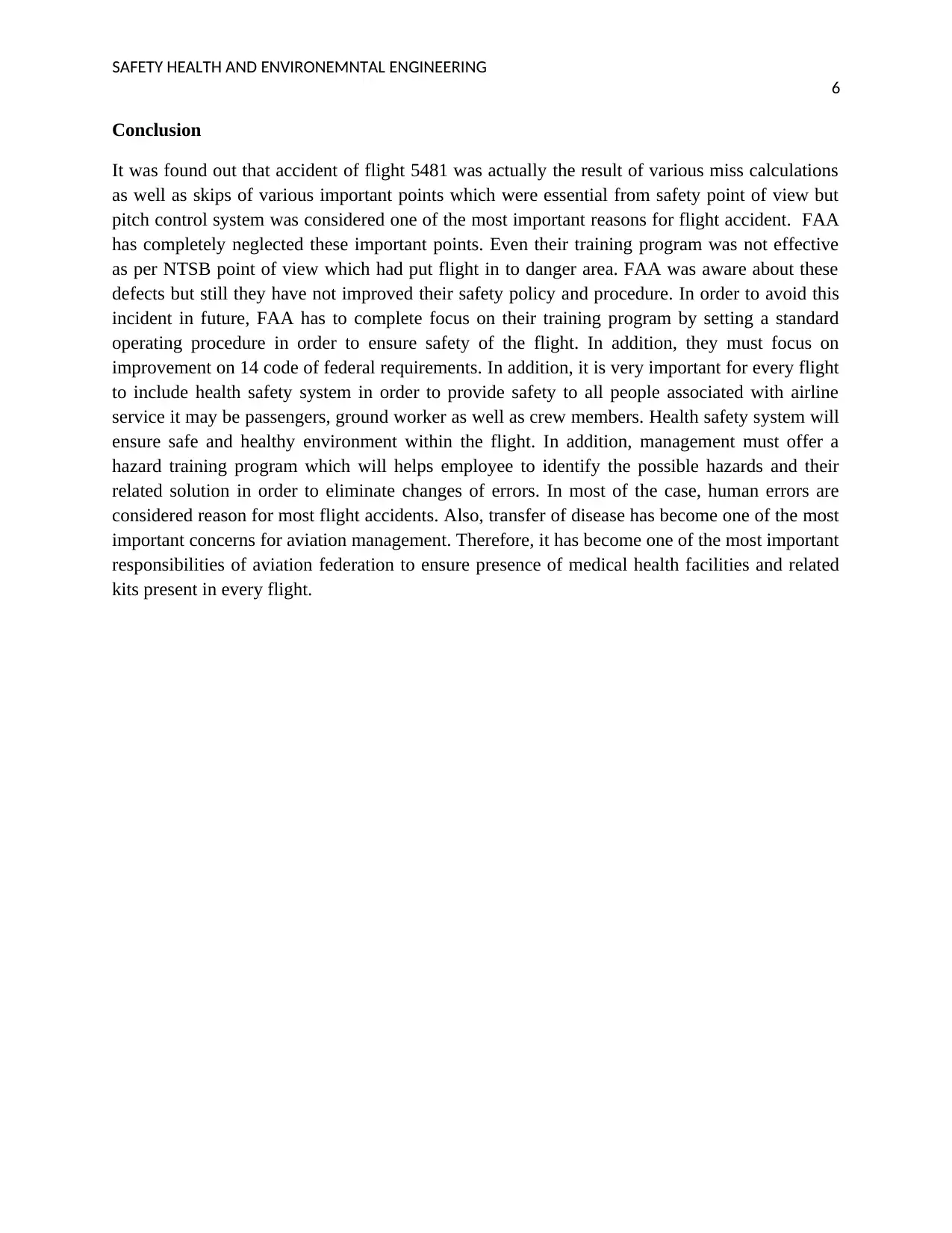
SAFETY HEALTH AND ENVIRONEMNTAL ENGINEERING
6
Conclusion
It was found out that accident of flight 5481 was actually the result of various miss calculations
as well as skips of various important points which were essential from safety point of view but
pitch control system was considered one of the most important reasons for flight accident. FAA
has completely neglected these important points. Even their training program was not effective
as per NTSB point of view which had put flight in to danger area. FAA was aware about these
defects but still they have not improved their safety policy and procedure. In order to avoid this
incident in future, FAA has to complete focus on their training program by setting a standard
operating procedure in order to ensure safety of the flight. In addition, they must focus on
improvement on 14 code of federal requirements. In addition, it is very important for every flight
to include health safety system in order to provide safety to all people associated with airline
service it may be passengers, ground worker as well as crew members. Health safety system will
ensure safe and healthy environment within the flight. In addition, management must offer a
hazard training program which will helps employee to identify the possible hazards and their
related solution in order to eliminate changes of errors. In most of the case, human errors are
considered reason for most flight accidents. Also, transfer of disease has become one of the most
important concerns for aviation management. Therefore, it has become one of the most important
responsibilities of aviation federation to ensure presence of medical health facilities and related
kits present in every flight.
6
Conclusion
It was found out that accident of flight 5481 was actually the result of various miss calculations
as well as skips of various important points which were essential from safety point of view but
pitch control system was considered one of the most important reasons for flight accident. FAA
has completely neglected these important points. Even their training program was not effective
as per NTSB point of view which had put flight in to danger area. FAA was aware about these
defects but still they have not improved their safety policy and procedure. In order to avoid this
incident in future, FAA has to complete focus on their training program by setting a standard
operating procedure in order to ensure safety of the flight. In addition, they must focus on
improvement on 14 code of federal requirements. In addition, it is very important for every flight
to include health safety system in order to provide safety to all people associated with airline
service it may be passengers, ground worker as well as crew members. Health safety system will
ensure safe and healthy environment within the flight. In addition, management must offer a
hazard training program which will helps employee to identify the possible hazards and their
related solution in order to eliminate changes of errors. In most of the case, human errors are
considered reason for most flight accidents. Also, transfer of disease has become one of the most
important concerns for aviation management. Therefore, it has become one of the most important
responsibilities of aviation federation to ensure presence of medical health facilities and related
kits present in every flight.
Paraphrase This Document
Need a fresh take? Get an instant paraphrase of this document with our AI Paraphraser
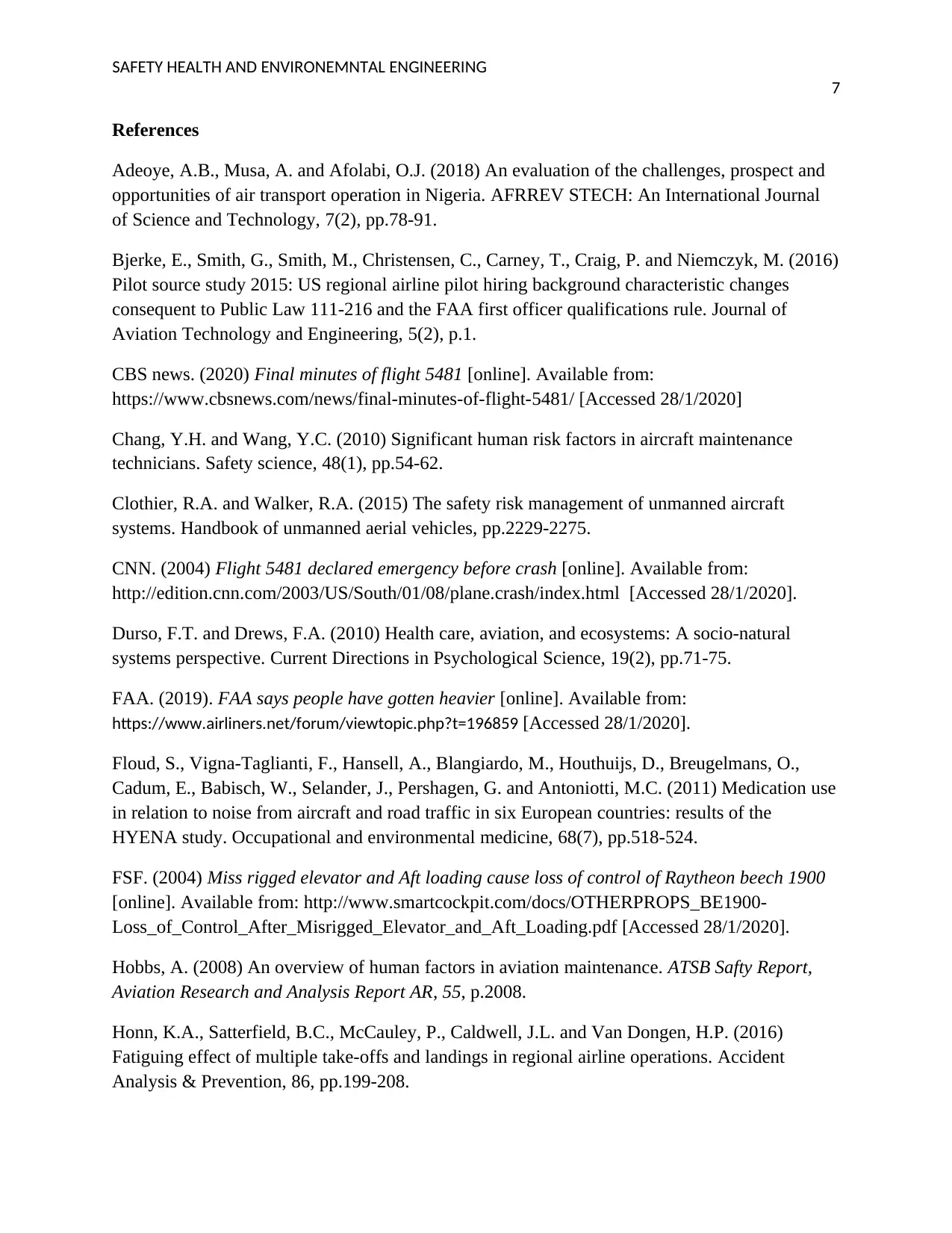
SAFETY HEALTH AND ENVIRONEMNTAL ENGINEERING
7
References
Adeoye, A.B., Musa, A. and Afolabi, O.J. (2018) An evaluation of the challenges, prospect and
opportunities of air transport operation in Nigeria. AFRREV STECH: An International Journal
of Science and Technology, 7(2), pp.78-91.
Bjerke, E., Smith, G., Smith, M., Christensen, C., Carney, T., Craig, P. and Niemczyk, M. (2016)
Pilot source study 2015: US regional airline pilot hiring background characteristic changes
consequent to Public Law 111-216 and the FAA first officer qualifications rule. Journal of
Aviation Technology and Engineering, 5(2), p.1.
CBS news. (2020) Final minutes of flight 5481 [online]. Available from:
https://www.cbsnews.com/news/final-minutes-of-flight-5481/ [Accessed 28/1/2020]
Chang, Y.H. and Wang, Y.C. (2010) Significant human risk factors in aircraft maintenance
technicians. Safety science, 48(1), pp.54-62.
Clothier, R.A. and Walker, R.A. (2015) The safety risk management of unmanned aircraft
systems. Handbook of unmanned aerial vehicles, pp.2229-2275.
CNN. (2004) Flight 5481 declared emergency before crash [online]. Available from:
http://edition.cnn.com/2003/US/South/01/08/plane.crash/index.html [Accessed 28/1/2020].
Durso, F.T. and Drews, F.A. (2010) Health care, aviation, and ecosystems: A socio-natural
systems perspective. Current Directions in Psychological Science, 19(2), pp.71-75.
FAA. (2019). FAA says people have gotten heavier [online]. Available from:
https://www.airliners.net/forum/viewtopic.php?t=196859 [Accessed 28/1/2020].
Floud, S., Vigna-Taglianti, F., Hansell, A., Blangiardo, M., Houthuijs, D., Breugelmans, O.,
Cadum, E., Babisch, W., Selander, J., Pershagen, G. and Antoniotti, M.C. (2011) Medication use
in relation to noise from aircraft and road traffic in six European countries: results of the
HYENA study. Occupational and environmental medicine, 68(7), pp.518-524.
FSF. (2004) Miss rigged elevator and Aft loading cause loss of control of Raytheon beech 1900
[online]. Available from: http://www.smartcockpit.com/docs/OTHERPROPS_BE1900-
Loss_of_Control_After_Misrigged_Elevator_and_Aft_Loading.pdf [Accessed 28/1/2020].
Hobbs, A. (2008) An overview of human factors in aviation maintenance. ATSB Safty Report,
Aviation Research and Analysis Report AR, 55, p.2008.
Honn, K.A., Satterfield, B.C., McCauley, P., Caldwell, J.L. and Van Dongen, H.P. (2016)
Fatiguing effect of multiple take-offs and landings in regional airline operations. Accident
Analysis & Prevention, 86, pp.199-208.
7
References
Adeoye, A.B., Musa, A. and Afolabi, O.J. (2018) An evaluation of the challenges, prospect and
opportunities of air transport operation in Nigeria. AFRREV STECH: An International Journal
of Science and Technology, 7(2), pp.78-91.
Bjerke, E., Smith, G., Smith, M., Christensen, C., Carney, T., Craig, P. and Niemczyk, M. (2016)
Pilot source study 2015: US regional airline pilot hiring background characteristic changes
consequent to Public Law 111-216 and the FAA first officer qualifications rule. Journal of
Aviation Technology and Engineering, 5(2), p.1.
CBS news. (2020) Final minutes of flight 5481 [online]. Available from:
https://www.cbsnews.com/news/final-minutes-of-flight-5481/ [Accessed 28/1/2020]
Chang, Y.H. and Wang, Y.C. (2010) Significant human risk factors in aircraft maintenance
technicians. Safety science, 48(1), pp.54-62.
Clothier, R.A. and Walker, R.A. (2015) The safety risk management of unmanned aircraft
systems. Handbook of unmanned aerial vehicles, pp.2229-2275.
CNN. (2004) Flight 5481 declared emergency before crash [online]. Available from:
http://edition.cnn.com/2003/US/South/01/08/plane.crash/index.html [Accessed 28/1/2020].
Durso, F.T. and Drews, F.A. (2010) Health care, aviation, and ecosystems: A socio-natural
systems perspective. Current Directions in Psychological Science, 19(2), pp.71-75.
FAA. (2019). FAA says people have gotten heavier [online]. Available from:
https://www.airliners.net/forum/viewtopic.php?t=196859 [Accessed 28/1/2020].
Floud, S., Vigna-Taglianti, F., Hansell, A., Blangiardo, M., Houthuijs, D., Breugelmans, O.,
Cadum, E., Babisch, W., Selander, J., Pershagen, G. and Antoniotti, M.C. (2011) Medication use
in relation to noise from aircraft and road traffic in six European countries: results of the
HYENA study. Occupational and environmental medicine, 68(7), pp.518-524.
FSF. (2004) Miss rigged elevator and Aft loading cause loss of control of Raytheon beech 1900
[online]. Available from: http://www.smartcockpit.com/docs/OTHERPROPS_BE1900-
Loss_of_Control_After_Misrigged_Elevator_and_Aft_Loading.pdf [Accessed 28/1/2020].
Hobbs, A. (2008) An overview of human factors in aviation maintenance. ATSB Safty Report,
Aviation Research and Analysis Report AR, 55, p.2008.
Honn, K.A., Satterfield, B.C., McCauley, P., Caldwell, J.L. and Van Dongen, H.P. (2016)
Fatiguing effect of multiple take-offs and landings in regional airline operations. Accident
Analysis & Prevention, 86, pp.199-208.
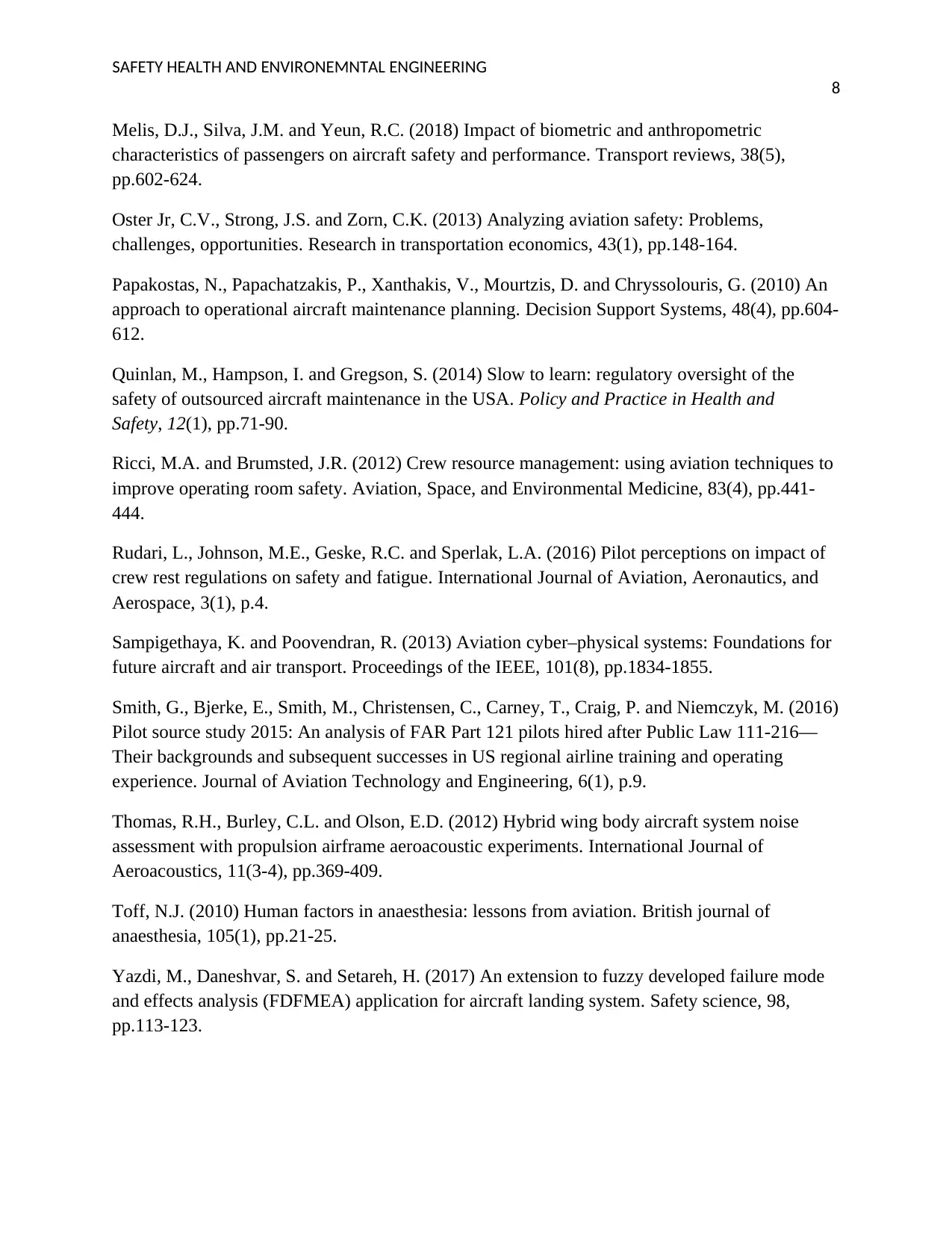
SAFETY HEALTH AND ENVIRONEMNTAL ENGINEERING
8
Melis, D.J., Silva, J.M. and Yeun, R.C. (2018) Impact of biometric and anthropometric
characteristics of passengers on aircraft safety and performance. Transport reviews, 38(5),
pp.602-624.
Oster Jr, C.V., Strong, J.S. and Zorn, C.K. (2013) Analyzing aviation safety: Problems,
challenges, opportunities. Research in transportation economics, 43(1), pp.148-164.
Papakostas, N., Papachatzakis, P., Xanthakis, V., Mourtzis, D. and Chryssolouris, G. (2010) An
approach to operational aircraft maintenance planning. Decision Support Systems, 48(4), pp.604-
612.
Quinlan, M., Hampson, I. and Gregson, S. (2014) Slow to learn: regulatory oversight of the
safety of outsourced aircraft maintenance in the USA. Policy and Practice in Health and
Safety, 12(1), pp.71-90.
Ricci, M.A. and Brumsted, J.R. (2012) Crew resource management: using aviation techniques to
improve operating room safety. Aviation, Space, and Environmental Medicine, 83(4), pp.441-
444.
Rudari, L., Johnson, M.E., Geske, R.C. and Sperlak, L.A. (2016) Pilot perceptions on impact of
crew rest regulations on safety and fatigue. International Journal of Aviation, Aeronautics, and
Aerospace, 3(1), p.4.
Sampigethaya, K. and Poovendran, R. (2013) Aviation cyber–physical systems: Foundations for
future aircraft and air transport. Proceedings of the IEEE, 101(8), pp.1834-1855.
Smith, G., Bjerke, E., Smith, M., Christensen, C., Carney, T., Craig, P. and Niemczyk, M. (2016)
Pilot source study 2015: An analysis of FAR Part 121 pilots hired after Public Law 111-216—
Their backgrounds and subsequent successes in US regional airline training and operating
experience. Journal of Aviation Technology and Engineering, 6(1), p.9.
Thomas, R.H., Burley, C.L. and Olson, E.D. (2012) Hybrid wing body aircraft system noise
assessment with propulsion airframe aeroacoustic experiments. International Journal of
Aeroacoustics, 11(3-4), pp.369-409.
Toff, N.J. (2010) Human factors in anaesthesia: lessons from aviation. British journal of
anaesthesia, 105(1), pp.21-25.
Yazdi, M., Daneshvar, S. and Setareh, H. (2017) An extension to fuzzy developed failure mode
and effects analysis (FDFMEA) application for aircraft landing system. Safety science, 98,
pp.113-123.
8
Melis, D.J., Silva, J.M. and Yeun, R.C. (2018) Impact of biometric and anthropometric
characteristics of passengers on aircraft safety and performance. Transport reviews, 38(5),
pp.602-624.
Oster Jr, C.V., Strong, J.S. and Zorn, C.K. (2013) Analyzing aviation safety: Problems,
challenges, opportunities. Research in transportation economics, 43(1), pp.148-164.
Papakostas, N., Papachatzakis, P., Xanthakis, V., Mourtzis, D. and Chryssolouris, G. (2010) An
approach to operational aircraft maintenance planning. Decision Support Systems, 48(4), pp.604-
612.
Quinlan, M., Hampson, I. and Gregson, S. (2014) Slow to learn: regulatory oversight of the
safety of outsourced aircraft maintenance in the USA. Policy and Practice in Health and
Safety, 12(1), pp.71-90.
Ricci, M.A. and Brumsted, J.R. (2012) Crew resource management: using aviation techniques to
improve operating room safety. Aviation, Space, and Environmental Medicine, 83(4), pp.441-
444.
Rudari, L., Johnson, M.E., Geske, R.C. and Sperlak, L.A. (2016) Pilot perceptions on impact of
crew rest regulations on safety and fatigue. International Journal of Aviation, Aeronautics, and
Aerospace, 3(1), p.4.
Sampigethaya, K. and Poovendran, R. (2013) Aviation cyber–physical systems: Foundations for
future aircraft and air transport. Proceedings of the IEEE, 101(8), pp.1834-1855.
Smith, G., Bjerke, E., Smith, M., Christensen, C., Carney, T., Craig, P. and Niemczyk, M. (2016)
Pilot source study 2015: An analysis of FAR Part 121 pilots hired after Public Law 111-216—
Their backgrounds and subsequent successes in US regional airline training and operating
experience. Journal of Aviation Technology and Engineering, 6(1), p.9.
Thomas, R.H., Burley, C.L. and Olson, E.D. (2012) Hybrid wing body aircraft system noise
assessment with propulsion airframe aeroacoustic experiments. International Journal of
Aeroacoustics, 11(3-4), pp.369-409.
Toff, N.J. (2010) Human factors in anaesthesia: lessons from aviation. British journal of
anaesthesia, 105(1), pp.21-25.
Yazdi, M., Daneshvar, S. and Setareh, H. (2017) An extension to fuzzy developed failure mode
and effects analysis (FDFMEA) application for aircraft landing system. Safety science, 98,
pp.113-123.
⊘ This is a preview!⊘
Do you want full access?
Subscribe today to unlock all pages.

Trusted by 1+ million students worldwide

SAFETY HEALTH AND ENVIRONEMNTAL ENGINEERING
9
Yazgan, e. and Kavsaoğlu, M.S. (2017) Evaluation of Stress Affecting Aircraft Maintenance
Technician‟ s Performance. International Journal of Computing, Communications &
Instrumentation Engineering, 4(1), pp.2349-1469.
9
Yazgan, e. and Kavsaoğlu, M.S. (2017) Evaluation of Stress Affecting Aircraft Maintenance
Technician‟ s Performance. International Journal of Computing, Communications &
Instrumentation Engineering, 4(1), pp.2349-1469.
1 out of 10
Related Documents
Your All-in-One AI-Powered Toolkit for Academic Success.
+13062052269
info@desklib.com
Available 24*7 on WhatsApp / Email
![[object Object]](/_next/static/media/star-bottom.7253800d.svg)
Unlock your academic potential
Copyright © 2020–2025 A2Z Services. All Rights Reserved. Developed and managed by ZUCOL.




